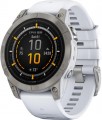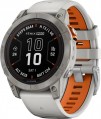Display type
— TFT. The simplest type of liquid crystal panel used in colour displays. They provide a relatively low, but generally sufficient image quality, while they are much cheaper than more advanced options. This type does not require backlight — more precisely, the backlight is part of the screen itself and turns on with it. Of the unequivocal disadvantages, it is worth noting that many
TFT panels have rather limited viewing angles; however, as technology improves, this drawback is gradually eliminated.
— IPS. A variety of LCD panels created in an attempt to eliminate the shortcomings of TFT. There are many subspecies
of IPS panels, but they all feature high colour reproduction quality, excellent brightness and wide viewing angles. The disadvantage of this option is the relatively high cost.
—
OLED. In this case, we mean the technology used to create the simplest monochrome displays. In such screens, each segment that makes up the image is a separate LED, which eliminates the need for external illumination (and even the display itself can be used as a
flashlight).
—
AMOLED. Screens based on a panel of active organic light emitting diodes. Similar to various types of TFT, this technology allows the creation of high-resolution colour displays. Its key feature is that the screen doe
...s not require a separate backlight system — in AMOLED panels, each pixel glows independently, resulting in somewhat lower power consumption. At the same time, such screens are distinguished by good colour reproduction quality, excellent brightness and wide viewing angles, however, they are much more expensive than TFT.
— Super AMOLED. An enhanced version of the AMOLED technology described above, delivering more expansive colour reproduction and brightness, as well as improved touch accuracy and speed, all at a thinner display and lower power consumption. In addition, the degree of reflection of external light is reduced, such a panel gives less glare and is better visible in sunlight.
— E-Ink (E-Paper). Displays made using "electronic paper" technology; in addition, this category also includes screens such as Memory LCD. The classic E-Ink screen is black and white, does not have a backlight (however, it can be built into particular gadgets), has a very low refresh rate and is poorly suited even for stopwatches, not to mention videos or animated pictures. On the other hand, "electronic paper" is perfectly visible in bright light and has a very low power consumption: it requires electricity only when the image is changed, while a still image remains visible even when the power is completely turned off. Memory LCD screens, in turn, with the same advantages, are almost as good as classic LCD panels in terms of refresh rate, but for a number of reasons they are not widely used.
— Transflective. A specific type of LCD panels that can work both due to its own backlight and due to reflected light. In bright external light (for example, in the sun), such a screen effectively reflects it and does not require a separate backlight — however, it is still included in the design and turns on in low light. This type of operation can significantly reduce power consumption compared to traditional LCD screens, where the image is not visible without backlight; in addition, good visibility in bright light is also an important advantage. The main disadvantage of panels of this type is their high cost; in addition, they are made mostly monochrome.
- LTPO. OLED and AMOLED matrices with an adaptive refresh rate that varies over a wide range based on the tasks performed. When rendering dynamic frames, screens with LTPO technology automatically raise the refresh rate to the maximum values, while viewing static images, they automatically reduce it to the minimum. At the heart of the technology is a traditional LTPS substrate with a thin TFT oxide film on top of the TFT base. Dynamic control of the refresh rate is provided by controlling the electron flow. The key benefit of LTPO screens is their reduced power consumption.Screen resolution
Screen size in dots (pixels) horizontally and vertically. In general, this is one of the indicators that determine the image quality: the higher the resolution, the clearer and smoother the picture on the screen (with the same size), the less noticeable are the individual dots. On the other hand, an increase in the number of pixels affects the cost of displays, their power consumption and requirements for a hardware platform (more powerful hardware is required, which itself will cost more). In addition, the specifics of using smartwatches is such that there is simply no need to install high-resolution screens in them. Therefore, modern wrist accessories use displays with a relatively low resolution: for example, 320x320 with a size of about 1.6" is considered quite sufficient even for premium watches.
PPI
The density of dots on the screen of the gadget, namely, the number of pixels that are on each inch of the panel vertically or horizontally.
The higher the PPI, the higher the detail of the screen, the clearer and smoother the image is. On the other hand, this indicator affects the price accordingly. Therefore, the higher the density of points, the more advanced, usually, this gadget is in terms of general capabilities. However, when choosing a screen, manufacturers take into account the general purpose and functionality of the device; so that even a small number of PPIs usually does not interfere with comfortable use.
Operating time (normal mode)
The time that the gadget can work on one battery charge (or the supplied battery) in normal use.
Normal mode, as a rule, means working with a relatively low load. At this time, the display can display some data, and basic functions can also work (counting steps, periodically checking heart rate, etc.), but in any case, power consumption is low. Therefore, the operating time in normal mode can be quite impressive, up to
several weeks, or even months. However, when choosing, it doesn’t hurt to also pay attention to the stated time in active mode (see below) — especially if a long operating time is critical, or you plan to use the gadget intensively. The actual autonomy of the device will most likely be somewhere in between these two values, depending on the actual load. If only the time in normal mode is indicated for the gadget, you should choose with a certain reserve.
Battery life (GPS)
The time that the gadget is able to work on one charge of the battery (or supplied battery) when using a GPS sensor.
This parameter is specified mainly for high-end tourist watches designed for experienced travelers, military, rescuers, divers, pilots, etc. Such devices use advanced GPS receivers, which themselves can consume quite a significant amount of energy; in addition, the operation of the receiver is inevitably accompanied by the use of other features — transferring navigation data to another device (usually via Bluetooth), working with its own built-in maps, etc. Therefore, the battery life while using GPS turns out to be rather modest — it can be significantly less time in active and even less in normal mode (for both, see above).
We also remind that the battery life mentioned in specs is approximate — in fact it may differ (in one direction or another, depending on the use scenario). Nevertheless, it is quite possible to evaluate the actual capabilities of the watch and compare them with each other: the difference in the claimed battery life usually proportionally corresponds to the difference in practical battery life.
Solar battery
A watch with a special photocell that
converts the energy of sunlight into electrical energy. Sunlight also commonly refers to artificial lighting emitted by fluorescent lamps and other light sources. The solar battery can't free you from charging the smartwatch, however, it significantly extends the operating time of the wearable gadget.
Weight
In most cases, the weight of the watch body itself is indicated as the weight of the model, since the strap is removable and can be replaced with another one. However, there are also models when the weight is presented with an included strap. Anyway, if the manufacturer indicates a specific method of measuring weight (with or without a strap), we add this information.

